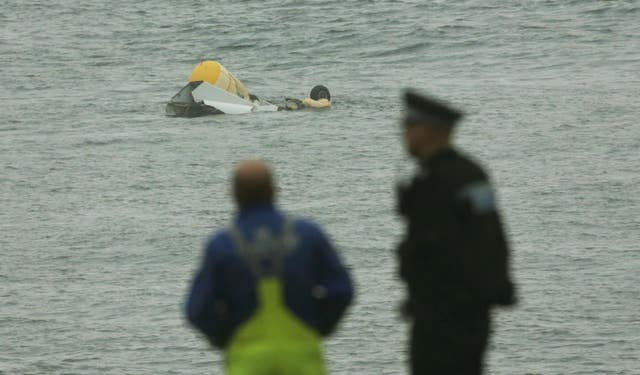Fatal crash claimed fifth victim after survivor took his own life, inquiry hears
Four people died when the Super Puma L2 helicopter ditched on the approach to Sumburgh Airport, Shetland, in 2013.

A helicopter which crashed into the North Sea killing four passengers claimed another victim after one of the survivors took his own life, a fatal accident inquiry heard.
The inquiry heard Samuel Bull, one of the 18 people on the Super Puma L2 when it ditched on its approach to Sumburgh Airport, Shetland, at 18.17pm on August 23 2013, died in East Dulwich, London, on December 10 2017.
Agreed evidence states an inquest held later that month in London said the offshore fuel analyst “bravely attempted to resuscitate another passenger” following the crash and had been receiving regular psychiatric treatment for post-traumatic stress disorder.
The inquest ruled his death was suicide.
Sheriff Principal Derek Pyle, who is hearing the inquiry, said he had spoken to Mr Bull’s father and stressed the importance of there being “another victim apart from the four that died on the day and his death was plainly directly caused by the accident”.
Sarah Darnley, 45, from Elgin, Moray; Gary McCrossan, 59, from Inverness; Duncan Munro, 46, from Bishop Auckland, County Durham, and George Allison, 57, from Winchester, Hampshire, died in the crash.

The inquiry also heard from Mr Bull’s colleague at the time of the crash, Matthew Bower, who he teamed up with to give CPR to Mr McCrossan who had a heart attack on their life raft after he escaped the downed helicopter.
Asked if his offshore training was helpful in dealing with the crash, Mr Bower, 31, said: “It saved my life on that day, yeah.”
The chemist had only flown offshore up to six times before the crash and was asleep until seconds before the aircraft hit the sea.
“We seemed to drop out of the cloud and I remember seeing the sea was significantly closer than expected. I hadn’t heard anything about coming into land at that point,” he said.
“Then it was quite clear that we were falling… I remember falling and I remember seeing sea coming towards us too quickly.
“We’ve hit the water and immediately it went over.”
He said the helicopter filled up “immediately” with water, his training kicked in and removed the window and got to the surface.
He said he did not use his rebreather as it was “convoluted” but this was not a conscious decision as there was no time.
Once at the surface he deployed his life jacket, saying this was under a minute from him waking up.
He saw people in the water, got on to the upturned helicopter and then a life raft where he tried to save Mr McCrossan’s life.

Agreed written evidence states Mr McCrossan died from a heart attack triggered by the stress of the crash.
Mr Bower has since returned to working offshore and has completed training including simulated ditching, believing the previous ditching training helped save his life.
“We were flipping lucky,” he said.
“If you fall from the sky at any other point it (training) really doesn’t matter because you’re going to die on impact.”
Survivor Paul Sharp, 55, also gave evidence, saying he believed he was going to die inside the downed helicopter before punching a window out to escape.
He said his life jacket only partially inflated and had to be topped up manually, the light and personal locator beacon did not work and criticised the emergency rebreather for being “hard to get to”.
Asked if he used it, he said he “couldn’t find it”.
An offshore scaffolder at the time, he said he returned offshore once but collapsed after the flight and vowed never to go back on a helicopter.
He suffers from nightmares, anxiety and depression.
Fellow survivor Mark Martin, 51, an offshore construction supervisor at the time, said he has not worked since the crash due to nightmares and flashbacks.
He warned crashes would “keep repeating and repeating” unless helicopters have upgraded technological surveillance.
Mr Martin remembers no ditching warning and said after the aircraft hit the water people tried to get out past him through exit windows which would not open.
He went towards Ms Darnley but believes she was dead, then found an airpocket and escaped through a window.
His survival suit filled with water and making him a “a bag of water in the water”, he said, rather than helping him float.
Modern training courses are a “joke”, he added, and should be remodelled to resemble his first course in the 80s which included harbour rescues and ditching with a wave machine, which he credited with his escape.





